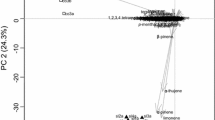Abstract
The chemical components of tarbush (Flourensia cernua) leaves were fractionated by extracting successively with hexanes, diethyl ether, and ethanol. Volatile profiles of each fraction were identified by using GC-MS. The hexanes fraction contained mostly monoterpenoids, while the ethanol fraction volatiles were primarily sesquiterpenoids. Crude fractions were tested for activity against fungi, algae, and termites. Application of as little as 1 μg of the essential oil from the hexanes fraction was sufficient to provide visible antifungal activity in bioautography assays. The diethyl ether fraction showed selective activity against the cyanobacterium responsible for the 2-methylisoborneol-induced off-flavor sometimes associated with catfish farming operations. All three fractions exhibited a high degree of antitermite activity.
Similar content being viewed by others
REFERENCES
ADAMS, R. P. 1995. Identification of Essential Oil Components by Gas Chromatography and Mass Spectroscopy. Allured Publishing, Carol Stream, Illinois.
DAYAN, F. E. and TELLEZ, M. R. 1999. Phytotoxicity of tarbush (Flourensia cernua DC). Allelopathy J. 6:1–12.
DILLON, M. O. 1984. A Systematic Study of Flourensia (Asteraceae, Heliantheae). Field Museum of Natural History, Chicago, Illinois.
DOLLAHITE, J. N. and ALLEN, T. J. 1975. The toxicity of the fruit of Flourensia cernua (tarbush) (Blackbrush). Southwest. Vet. 28:113–117.
DUKE, S. O., CANEL, C., RIMANDO, A. M., TELLEZ, M. R., DUKE, M. V., and PAUL, R. N. 2000. Current and potential exploitation of plant glandular trichome productivity. Adv. Bot. Res. 31: 121–152.
ESPINEL-INGROFF, A. and KERKERING, T. M. 1991. Spectrophotometric method of inoculum preparation for the in vitro susceptibility testing of filamentous fungi. J. Clin. Microbiol. 29:393–394.
ESTELL, R., TELLEZ, M., FREDRICKSON, E., ANDERSON, D., HAVSTAD, K., and REMMENGA, M. 2001. Extracts of Flourensia cernua reduce consumption of alfalfa pellets by sheep. J. Chem. Ecol. 27:2277–2287.
HIMEJIMA, M. HOBSON, K., OTSUKA, T., WOOD, D., and KUBO, I. 1992. Antimicrobial terpenes from oleoresin of ponderosa pine tree Pinus ponderosa: A defense mechanism against microbial invasion. J. Chem. Ecol. 18:1809–1818.
HOMANS, A. L. and FUCHS, A. 1970. Direct bioautography on thin-layer chromatograms as a method for detecting fungitoxic substances. J. Chromatogr. 51:327–329.
MATHEWS, F. 1944. The toxicity of the ripe fruit of blackbrush or tarbrush (Flourensia cernua) for sheep and goats. Texas Agric. Exp. Stn. Bull. No. 664.
MIYAKADO, M., KATO, T., OHNO, N., and MABRY, T. J. 1976. Pinocembrin and (+)-β-eudesmol from Hymenoclea monogyra and Baccharis glutinosa. Phytochemistry 15:846.
NIST/EPA/NIH 1990. NIST/EPA/NIH 75K MS Library.
ONAWUNMI, G., YISAK, W., and OGUNLANA, E. 1984. Antibacterial constituents in the essential oil of Cymbopogon citratus (DC.) Stapf. J. Ethno-Pharmacol. 12:279–286.
PAERL, H. W. and TUCKER, C. S. 1995. Ecology of blue-green algae in aquaculture ponds. J. World Aquacult. Soc. 26:109.
SCHRADER, K., DE REGT, M., TUCKER, C., and DUKE, S. 1997. A rapid bioassay for selective algicides. Weed Technol. 11:767–774.
TELLEZ, M., ESTELL, R., FREDRICKSON, E., and HAVSTAD, K. 1997. Essential oil of Flourensia cernua DC. J. Essent. Oil Res. 9:619–624.
TELLEZ, M. R., CANEL, C., RIMANDO, A. M., and DUKE, S. O. 1999. Differential accumulation of isoprenoids in glanded and glandless Artemisia annua L. Phytochemistry 52:1035–1040.
TELLEZ, M. R., DAYAN, F. E., SCHRADER, K. K., WEDGE, D. E., and DUKE, S. O. 2000. Composition and some biological activities of the essential oil of Callicarpa americana (L.). J. Agric. Food Chem. 48:3008–3012.
VAN DER PLOEG, M., DENNIS, M. E., and DE REGT, M. Q. 1995. Biology of Oscillatoria Cf. Chalybea, A 2-Methylisoborneol producing blue-green alga of Mississippi catfish ponds. Water Sci. Technol. 31:173.
WEDGE, D. and KUHAJEK, J. 1998. A microbioassay for fungicide discovery. SAAS Bull. Biochem. Biotechnol. 11:1–7.
WEDGE, D. and NAGLE, D. G. 2000. A new 2D-TLC bioautography method for the discovery of novel antifungal agents to control plant pathogens. J. Nat. Prod. 63:1050–1054.
Author information
Authors and Affiliations
Rights and permissions
About this article
Cite this article
Tellez, M., Estell, R., Fredrickson, E. et al. Extracts of Flourensia cernua (L): Volatile Constituents and Antifungal, Antialgal, and Antitermite Bioactivities. J Chem Ecol 27, 2263–2273 (2001). https://doi.org/10.1023/A:1012283005014
Issue Date:
DOI: https://doi.org/10.1023/A:1012283005014




